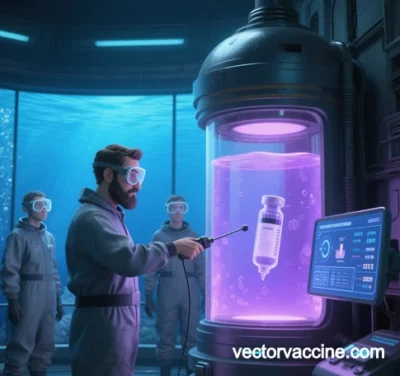
The Future of Novel Technologies in Vaccine Vector Development
Vaccine vectors, as a cornerstone of modern vaccine development, are undergoing transformative advancements through innovations in virology, nucleic acid engineering, nanomaterials, and artificial intelligence. These breakthroughs are ushering in an era of precision, modularity, and programmability. Below is a comprehensive analysis of emerging trends across technological innovation, expanded applications, and global scalability.
I. Multidimensional Optimization of Viral Vector Technologies
1. Adenoviral Vectors: Overcoming Pre-existing Immunity and Delivery Barriers
- Heterologous Prime-Boost Strategies: The Sputnik V vaccine (Ad26/Ad5 hybrid) achieved 91% efficacy by alternating serotypes to evade pre-existing immunity .
- Non-humanized Design: ChAdOx1, a chimpanzee adenovirus, avoids human antibody neutralization, enabling single-dose T-cell activation (70% COVID-19 efficacy) .
- Mucosal Delivery: CanSino’s inhaled adenovirus vaccine elevates respiratory IgA levels threefold compared to intramuscular administration .
2. Poxvirus and AAV Vectors: Balancing Capacity and Safety
- Multipathogen Protection: Poxvirus vectors (>25 kb capacity) co-express HIV envelope and influenza hemagglutinin antigens .
- Low Immunogenicity: AAV vectors induce strong antigen-specific responses with minimal capsid reactivity, ideal for chronic diseases like HIV .
3. Avian-derived Vectors: Cross-species Potential
- Newcastle disease virus (NDV), with avian-specific tropism, bypasses human pre-immunity and is being tested for H5N1 and Ebola vaccines .
II. mRNA Technology Revolution: From Pandemics to Personalized Medicine
1. Delivery System Enhancements
- LNP Optimization: Cationic lipids (e.g., SM-102) increase lymph node targeting to 70% while reducing hepatotoxicity .
- Self-amplifying mRNA (saRNA): RNA replicons extend antigen expression to 72 hours, cutting dose requirements by 90% .
2. AI-driven Design
- Antigen Prediction: AlphaFold2 optimizes mRNA sequences for epitope conformation, shortening development cycles by 60% .
- Synthetic Nucleotides: AI-designed methylation patterns reduce TLR-mediated inflammatory responses .
3. Therapeutic Expansion
- Neoantigen Vaccines: BioNTech’s iNeST platform extends melanoma progression-free survival by 4.6 months via personalized mutations .
- Protein Replacement: mRNA-encoded Factor VIII sustains expression >28 days in hemophilia models .
III. Next-generation Delivery Systems: Nanotechnology and Biomimetics
1. Multifunctional Nanoparticles
- Antigen-Adjuvant Co-delivery: Silica nanoparticles loaded with influenza HA and CpG boost antibody titers eightfold in mice .
- Stimuli-responsive Release: Photothermal platinum nanoparticles trigger antigen release in tumors, synergizing with PD-1 inhibitors .
2. Biomimetic Carriers
- Virus-like Particles (VLPs): SARS-CoV-2 VLPs mimic native virions, eliciting neutralizing antibodies 3–5× higher than inactivated vaccines .
- Bacterial Membrane Coating: E. coli outer membrane vesicles (OMVs) deliver mRNA, enhancing Th1 responses for tuberculosis vaccines .
IV. Synthetic Biology: Modular and Scalable Platforms
1. Engineered Synthetic Vectors
- Minimal Genomes: Yeast “chassis cells” with 90% non-essential genes removed produce malaria antigens at BSL-1 safety levels .
- Non-viral DNA Carriers: 3DNA® delivers 50 kb gene clusters, restoring 30% dystrophin in Duchenne muscular dystrophy models .
2. Low-cost Manufacturing
- Plant-based Production: Tobacco mosaic virus (TMV) expresses influenza antigens at $0.1/dose, ideal for low-resource regions .
- Continuous Flow Processes: Modular bioreactors automate mRNA production, achieving 1 billion annual doses .
V. Industrialization and Global Health Impact
1. Combating Viral Variants
- Broad-spectrum Vaccines: Adenovirus vectors encoding conserved coronavirus S2 and influenza M2e achieve >60% cross-protection in mice against Beta and Omicron .
- Rapid Response: mRNA platforms compress vaccine design-to-production timelines to 30 days for pandemic preparedness .
2. Enhancing Accessibility
- Thermostable Formulations: DNA vaccines embedded in trehalose-glass matrices withstand 40°C for 6 months (e.g., ZyCoV-D in India) .
- Regional Manufacturing: WHO’s African mRNA hubs produce cholera and malaria vaccines at <$2/dose using modular systems .
Future Challenges and Breakthrough Directions
- Safety Monitoring: Genome-wide integration site databases are needed to track adenoviral vector insertion hotspots .
- Multivalent Vaccines: CRISPR-Cas9 enables insertion of 10+ epitopes into poxvirus vectors for “super-vaccine” development .
- Barrier Penetration: Engineered AAV9 crosses the blood-brain barrier, achieving protective rabies antibody levels in primates .
Conclusion
The convergence of novel technologies is transforming vaccine vectors from passive defenses into actively engineered solutions for infectious diseases, cancer, and genetic disorders. Over the next five years, advancements in AI-synthetic biology integration, nanodelivery systems, and decentralized production will solidify vaccine vectors as indispensable tools against pathogens and chronic conditions.
Data sourced from public references. For collaborations or domain inquiries, contact: chuanchuan810@gmail.com.




